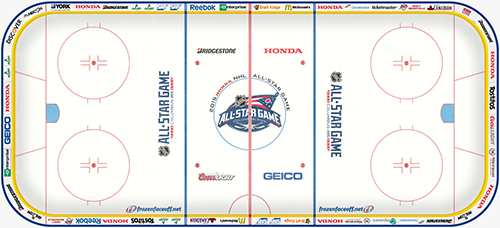Attend any NHL game today and you’ll be bombarded by colorful ads from large corporations. From arena sponsorship signage to dasher board and on-ice advertising, there’s no avoiding it; and there’s more every year.
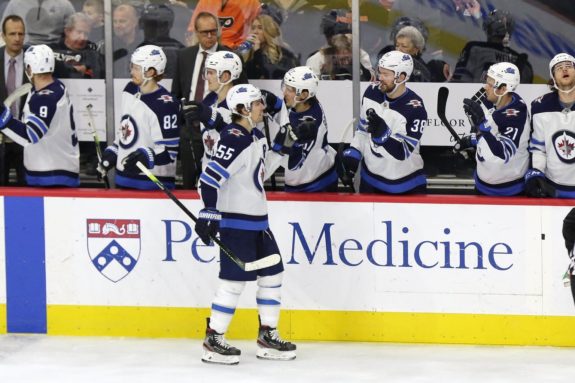
There’s a long history of advertising in hockey. Here we’ll look specifically at advertising and sponsorships around the arenas–on the boards, sections, and naming rights.
Rink Board Advertising
One of the most prominent forms of advertising in hockey comes from the ads we see plastered on every inch of the dasher boards in rinks around the world. Those of us who remember watching the NHL before the 1980s can reminisce about the white boards that featured nothing more than marking lines and thousands of black scuffs from repeated abuse from pucks.
Starting with the 1978-79 season, NHL teams were allowed to sell ad space on their rink boards. However, the first display ad featured on an NHL rink board appeared in 1980. The Minnesota North Stars were the first NHL franchise to feature dasher board ads and sold eight pairs of rink boards for $3,000 a pair.
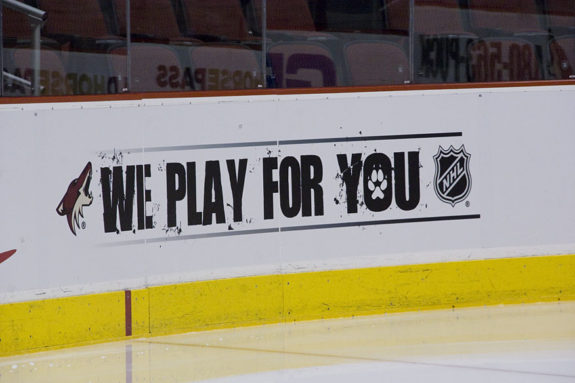
Since then, franchises have sold every inch of ad space allowed by the NHL to corporations and local businesses who want their logos and products in front of hockey fans.
Dasher Board Dimensions
The typical dimensions of dasher board graphics are 30 to 33 inches in height and around six to twelve feet in length. These graphics are usually adhesive decals that installers place on the boards.
Emerging Advertising
As technology has evolved so has the many forms of advertising which have helped fuel new revenue streams for franchises and hockey-related media, including dynamic digital rinkside board ads (which allow for different ads to be displayed during the same game), virtual ads on the glass (which television viewers see) and video game advertising.
The first iteration of the virtual ad technology was briefly tested by the New York Rangers and MSG Network in 2008-09. During the 2010-11 season, the Philadelphia Flyers got in on the action by selling virtual ad units and generated north of half a million dollars throughout the season.
To put the revenue into perspective, the Flyers paid $2,700 a game in production costs to Sportvision, the firm that the NHL uses to operate the virtual sign system. The Flyers then sold the space for $3,500 a game to advertisers like Verizon, McDonald’s, Toyota and Geico.
In 2016, the NHL began experimenting with a virtual overlay on rink-side boards that allowed a single brand to appear on all of the boards in the Air Canada Centre at one time. Television viewers saw a single brand take over all the boards using digital technology. Though a pioneering moment for the NHL, the technology has been used for years by La Liga in Spain for ads during soccer games.
This system offers tremendous flexibility for the NHL, which has different marketing partnerships per region. For example, Canadian viewers may see ads from brands such as Tim Hortons and Canadian Tire, while American viewers see ads for Geico and DraftKings. Clubs can even sell to local or regional marketers. Another advantage is a brand can present dynamic messaging vs. a logo.
However, installing the technology–an invisible film over the boards–is expensive and requires further testing to withstand the rigors of NHL play, so it may take time to implement it league-wide.
On-Ice Advertising
At Frozenfaceoff.net, nearly every NHL team’s rink and their advertisements are featured.
Throughout the 1980s, advertising along the boards began popping up at arenas everywhere. By the end of the decade, every NHL team featured ads on their boards. By the 1990s ads had spilled onto the ice surface and are now featured in the neutral zone of every NHL arena, conservative in comparison to other leagues.
Some European and ECHL rinks host an explosion of shapes and colors all over the ice. Below is a picture of the Oulun Energia Areena, home of the Oulun Kärpät, of the SM-liiga in Finland. It’s a collage of mismatched sizes that make the ice look a mess.
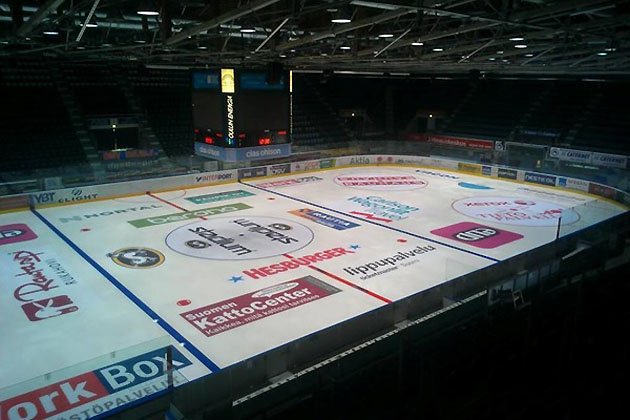
With so many brands scattered across the fast-paced space of a hockey rink, it’s difficult to capture the attention of fans. It can also make it hard to follow the puck against such a busy surface of colors and shapes.
The Montreal Canadiens doubled their logo at center ice at the Forum. They continued the tradition at Bell Centre until 2018, when they opted for one giant Habs logo. Similarly, the Detroit Red Wings cleaned up their ice, removing “Hockeytown” from center ice when they moved to the new Little Caesars Arena.
Related: The Montreal Forum 1908-1996
Starting with the 2018-19 season, teams were permitted to sell advertising in four new locations, the corners below the goal lines. It was a concept the league experimented with at the All-Star Game in January 2018, as well as the China Games between the Vancouver Canucks and Los Angeles Kings in September.
It’s the first new advertising space on the ice since the early 1990s, when teams were newly permitted to paint four sponsor logos in the neutral zone. The new corner ads can be up to 44 square feet in size, smaller than the neutral zone logos, which can be up to 81 square feet.
Jersey Ads
Currently, the NHL doesn’t feature any outside advertising on its jerseys, and fans have made it clear that they are strongly against any effort to do so. In Europe, however, jersey ads are common. They’ve been selling on-jersey ad space for decades, with uniforms that would be fitting for NASCAR.
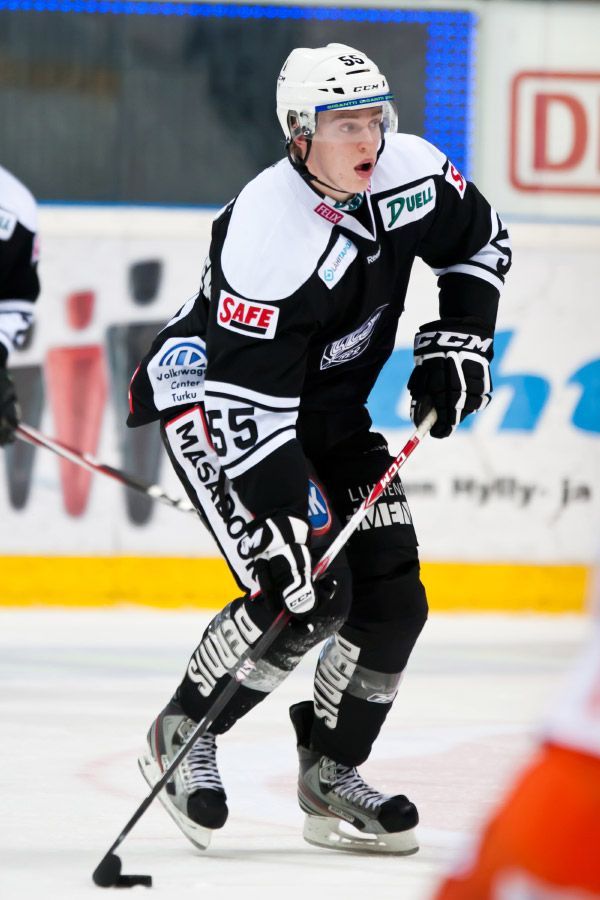
On-jersey ads is an idea the NHL has kicked around for some time. Several years ago, it was reported that such a move could generate $120 million in revenue for the league.
However, on-jersey ads reach far beyond the rink to the fans who buy them and, in turn, they become moving display ads. What immediately comes to mind are European soccer clubs. The major sponsor becomes just as prominent as the team itself.
Adidas’s seven-year partnership to be the NHL’s official jersey and licensed apparel provider is estimated to be worth double the $35 million Reebok paid until 2017 as the previous equipment sponsor.
Arena Sponsorships
Another key component to advertising is arena sponsorship. Of the 32 NHL rinks, all but one has a corporate sponsor, Madison Square Garden, home of the New York Rangers.
Such sponsorship deals typically cost several million dollars a year and are signed anywhere from a few years to several decades. For instance, Scotiabank signed a 20-year deal worth $800 million in 2017 to sponsor the Toronto Maple Leafs’s arena. That price tag is enormous. It’s more than 10 times what Air Canada paid for the inaugural rights nearly two decades ago and head and shoulders above similar deals elsewhere in the country.
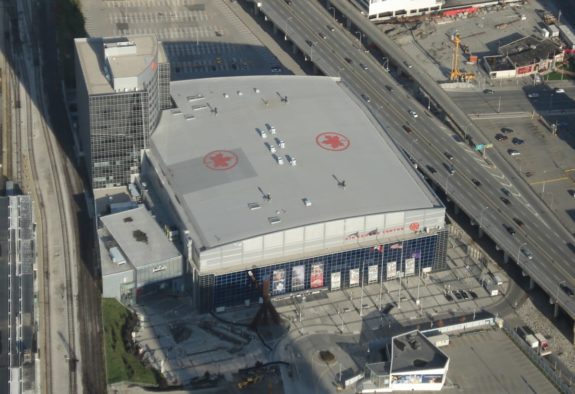
Scotiabank believes the investment is worth the price tag because hockey is “core to our strategy,” said Jacquie Ryan, the bank’s vice-president of sponsorship and philanthropy.
Other in-arena advertising can include intermission entertainment sponsorships and giveaways to sponsoring certain sections of the arena.
Stay tuned for part two of this series when we look at broadcast commercials and online advertising as well as emerging ad formats.
More Space Means More Money
While fans and players want to keep NHL jerseys pure, the day will come when we see ads on them. It happened in the NBA a few years ago. “Eighteen NBA teams have deals to display small jersey patches on the front of their uniforms, with the Golden State Warriors’ deal with Rakuten reaching $20 million per year,” reports the Sport Business Journal.
The bottom line is that a hockey is a business and ads help each franchise earn money. The ice surface and uniforms are prime real estate for advertisers, and adding logos means more revenue, especially for a lucrative television market and during sports highlight shows.

